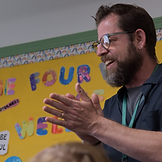Measuring What Matters.
We measure as an act of service. Our attention rests on protecting the energy of educators and noticing quiet patterns of change that unfolds through humble, continuous learning. Here are our eight insights that guides our work:

1) Measure to Serve, Not to Prove
We measure only what helps us serve educators better. Each metric must help us listen more deeply, rather than self-validation.
2) Protect Educator Energy
Every question we teachers, draws from the same reservoir of energy that serves their kids. We favor simple pulse checks, reflective conversations, and light observations.
3) Collected Metrics Must Move Decisions
Each metric must name the decision it informs and the threshold that triggers action. We must apply a design discipline to know when to stop measuring.
4) Metrics Must Be Paired With Meaning
Instead of proving causation, we seek contribution: What patterns emerge, for whom, and why? Metrics reveal patterns; stories reveal meaning.
5) Scale Deep → Out → Up
Change begins with individual educators who see value in their practice. Engage school leaders as early as possible to sustain the systems that allow change.
6) Learn in Feedback Loops
We move in feedback loops: observe, interpret, adapt. Our “Ripple Reports” replace long, static reports because progress is iterative, not declarative.
7) Donors As Learning Partners
Donors are our partners in understanding the dynamic system of serving schools. We ask for multi-year support to refine and learn how to serve deeply, together.
8) Let Communities Own The Results
Money can open doors; it must not set direction or define success on its terms. Our role fades by design, lasting change belongs to those who live it daily.
A Growing Global Movement
.png)
.jpg)

.jpg)
11 Countries
315+ Schools
11,925 Educators
409,625 Students
What Schools Are Reporting
A 2023 Global Impact Analysis revealed that when educators thrive, students and schools do too — across wellbeing, relationships, and culture.
Educator & School Feedback
-
86% personal benefits outside school
-
84% staff professional improvements
-
77% improved family relationships
-
87% improved student wellbeing
Classroom Improvements
-
54% increased student wellbeing
-
51% improved classroom climate
-
63% stronger student relationships
-
62% reduction in bullying
School Outcomes
-
63% belonging & compassion
-
61% educational quality
-
70% staff job satisfaction
-
60% better collaboration
Theory of Change
.png)
